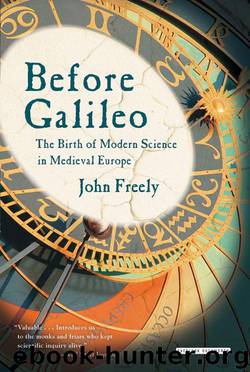Before Galileo: The Birth of Modern Science in Medieval Europe by Freely John

Author:Freely, John [Freely, John]
Language: eng
Format: azw3
Tags: HIS010000, SCI034000, SCI000000, HIS000000
ISBN: 9781468308501
Publisher: Overlook
Published: 2013-08-26T16:00:00+00:00
9
Over the Rainbow
NATURE ITSELF WAS THE FIRST PHYSICS LABORATORY, AND AMONG natural phenomena there are none that are more beautiful and spectacular than the rainbow. It cries out for an explanation, and long before science this took the form of myths, with the ancient Greeks imagining that the rainbow was the path made by the goddess Iris when Zeus sent her to earth with a message. Being Irish, I was told by my paternal grandfather Tomas that the leprechaun’s secret hiding place for his pot of gold is at the end of the rainbow, but he didn’t tell me which end.
Aristotle was the first to attempt a scientific explanation of the rainbow, and his work formed the basis for subsequent research in medieval Islam and Latin Europe. Robert Grosseteste’s work on the rainbow, though it was mistaken in some of its basic ideas, was the starting point for those who followed him in their study of optics, some of their experiments being designed to simulate the rainbow.
We usually see a rainbow in the morning or evening after a rain shower; standing with our back to the sun, it appears as an arc with the full spectrum of visible light ranging from red on the outside to violet on the inside. The center of the bow is exactly opposite the sun relative to the observer, and if you move forward or backward the rainbow moves with you, so the leprechaun’s pot of gold remains safe, or so Tomas told me. If you have a friend with you, he has his own rainbow that moves with him. The arc makes an angle of 40 to 42° with the direction opposite the sun.
This is the primary rainbow. There is often a fainter secondary rainbow visible outside the primary arc, making an angle of 50 to 53°. The spectrum of colors in the secondary rainbow is the reverse of that in the primary arc, with violet on the outside and red on the inside. The dark region between the primary and secondary rainbows is known as Alexander’s band.
As we shall see, during the thirteenth and early fourteenth centuries a succession of scholars beginning with Grosseteste did research on the rainbow, laying the foundations for the theory that Newton published early in the eighteenth century. There, as we learned, Newton explained the rainbow as being due to a combination of reflection, refraction, and dispersion, or the division of sunlight into its component colors, a continuous spectrum extending from red to violet. The rainbow is due to sunlight passing through individual droplets of rain remaining from a shower. In the primary rainbow the light is refracted when it enters the drop, reflected internally at its back surface, and then refracted again as it leaves. In the secondary rainbow the light undergoes two internal reflections, inverting the spectrum of colors.
Grosseteste’s work on the rainbow inspired some verses written about 1270 by the French poet Jean de Meun in his continuation of Guillaume de Lorris’s Romance of the Rose.
Download
This site does not store any files on its server. We only index and link to content provided by other sites. Please contact the content providers to delete copyright contents if any and email us, we'll remove relevant links or contents immediately.
Enlightenment Now: The Case for Reason, Science, Humanism, and Progress by Steven Pinker(7228)
A Journey Through Charms and Defence Against the Dark Arts (Harry Potter: A Journey Through…) by Pottermore Publishing(4781)
The Immortal Life of Henrietta Lacks by Rebecca Skloot(4525)
A Journey Through Divination and Astronomy by Publishing Pottermore(4344)
Elon Musk by Ashlee Vance(4028)
Origin Story: A Big History of Everything by David Christian(3648)
COSMOS by Carl Sagan(3554)
Alchemy and Alchemists by C. J. S. Thompson(3449)
Bad Pharma by Ben Goldacre(3355)
Enlightenment Now by Steven Pinker(3335)
Shadow of Night by Deborah Harkness(3302)
Inferior by Angela Saini(3276)
A Mind For Numbers: How to Excel at Math and Science (Even If You Flunked Algebra) by Barbara Oakley(3217)
Origin Story by David Christian(3147)
The Code Book by Simon Singh(3074)
Signature in the Cell: DNA and the Evidence for Intelligent Design by Stephen C. Meyer(3071)
The Elements by Theodore Gray(2998)
A Brief History of Time by Stephen Hawking(2960)
A Journey Through Potions and Herbology (A Journey Through…) by Pottermore Publishing(2826)
